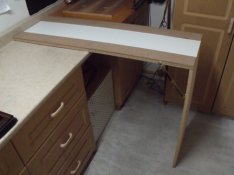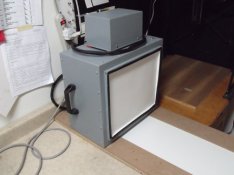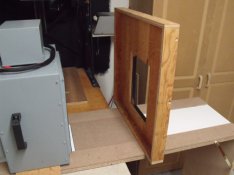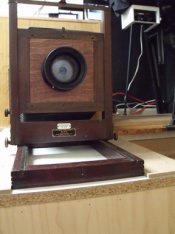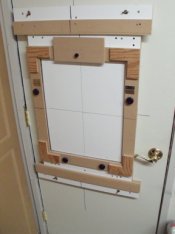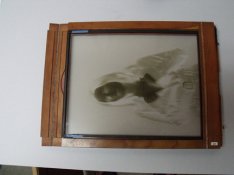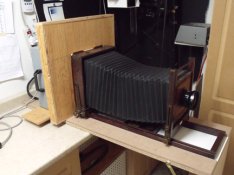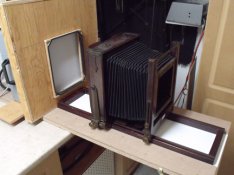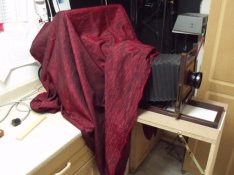Dan Dozer
Subscriber
- Joined
- Dec 10, 2004
- Messages
- 413
- Format
- Large Format
Someone asked to see photographs of my project to convert my 8 x 10 Kodak 2D enlarger into an 8 x 10 enlarger so here are some images of it.
Image 1 shows the table base that sits on my darkroom countertop (and clamped down). Base is hinged for easy storage and vertical piece sits on the floor. The base is made out of 3/4" melamine surfaced partical board which has two thin masonite pieces on top that forms the track that the camera base sits/slides in.
Image 2 shows the 10 x 10 cold light head that sits on the back end of the base.
Image 3 shows the vertical panel with the 8 x 10 hole cut in it that slides in the track that the camera slides in. The vertical panel is pushed up against the front of the Cold Ligtht head.
Image 4 shows the front side of the panel that the camera is pushed up against. I made a little frame with a foam rubber seal that sort of seals up against the camera back (see image 5).
Image 5 shows a close up view of the frame that closes up against the camera back. It was a little tricky to figure out how to make the frame and get a reasonably good seal to the camera back.
More images to follow.
Image 1 shows the table base that sits on my darkroom countertop (and clamped down). Base is hinged for easy storage and vertical piece sits on the floor. The base is made out of 3/4" melamine surfaced partical board which has two thin masonite pieces on top that forms the track that the camera base sits/slides in.
Image 2 shows the 10 x 10 cold light head that sits on the back end of the base.
Image 3 shows the vertical panel with the 8 x 10 hole cut in it that slides in the track that the camera slides in. The vertical panel is pushed up against the front of the Cold Ligtht head.
Image 4 shows the front side of the panel that the camera is pushed up against. I made a little frame with a foam rubber seal that sort of seals up against the camera back (see image 5).
Image 5 shows a close up view of the frame that closes up against the camera back. It was a little tricky to figure out how to make the frame and get a reasonably good seal to the camera back.
More images to follow.








